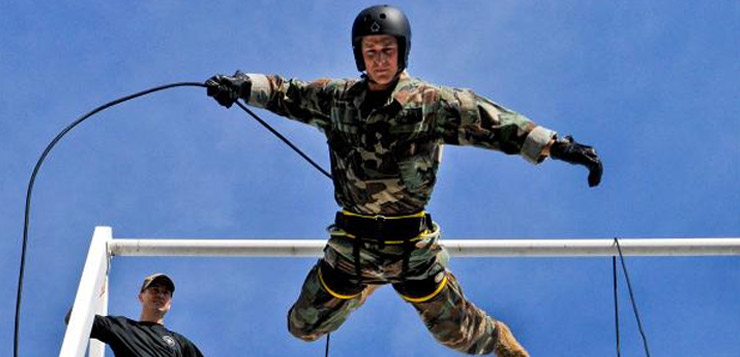Preparing for any Special Operations training program can be challenging and often lead to questioning yourself if you are tough enough to endure. Who knows at the moment when you become physically exhausted will be you able to suck it up and not quit? This week’s email question has more to do with mental toughness than physical preparation concerning recent statistic about the BUD/S Physical Screening Test (PST) minimum standards.
Stew – I read that if you just reach the minimum standards at BUD/S on the entrance PST you have a 6% chance of graduating SEAL training. As you know these minimums are:
— Swim 500 yards. Maximum time allowed is 12 minutes, 30 seconds
— utilizing only the side or breast stroke. The Combat Swimmer Stroke is a nick name for the side stroke with only a slight arm pull modification.
— Max push-ups. Minimum number is 42 in 2 minutes
— Max sit-ups. Minimum number is 50 in 2 minutes
— Max pull-ups. Minimum is six with no time limit, but you cannot touch the ground or let go of the bar.
— 1.5-mile run. Wearing boots and pants, the maximum time allowed for this one is 11 minutes, 30 seconds, in shoes you have 11 minutes.
How can anyone finish BUDS going into it with only 6 pull-ups and these slow run and swim times?
Great question – however, now with the Naval Special Warfare Mentor program, no mentor will sign off on you attending boot camp with these minimum standards. Now, the BUD/S requirements are a bit elevated and will actually test the students on their max effort though push scores in this range before they go to boot camp:
Swim 500 yards – 9-10 minutes
Max Pushups – 80-100 reps
Max Situps – 80-100 reps
Max pull-ups – 15-20 reps
1.5 mile run – 9-10 minutes
But this does not answer your question. The answer is to basically know how to play with pain and discomfort.
The skill you must practice and learn how to do is to disassociate. Since I was introduced to this concept, I interviewed several SEALs, physiologists, and psychologists as well as thought about my own experiences. It was confirmed by all parties – Spec Ops students and scientists alike – the ability to disassociate is a highly useful skill that can be used in athletics, daily life, as well as SEAL training.
The ability to disassociate should not be confused with the disassociate disorder often caused by traumatic events, but rather realized as a method to endure long, painful, uncomfortable, and tiring events like Hell Week or cold water exposure. Everyone I spoke with had a unique story how they were able to disassociate. Here are several examples:
1 – Pain – A dental visit using no pain killer when getting a cavity filled. Many endured this with a focus on a “happy place” or gazing at a tiny spot on the ceiling. I tried this ONCE – I made it but realized my disassociation skills were not as strong as I thought.
2 – Competitive / Long Distance Running – Many marathon runners spend the first few miles getting their pace down and then spend the next 20 or so miles focusing on something else like building a house brick by brick to help with the monotony of running 26.2 miles. Then they come back and finish strong with that final kick that requires more focus to accomplish.
3 – Swimming – Many swimmers call what they do for hours at a time going into a “swim coma”. Looking at the black line for 6000m requires the mind to wander, but also to be physically in the event itself. Many collegiate swimmers talk about writing term papers while swimming.
4 – High Rep PT – When you do workouts preparing for BUD/S, the total reps in a pyramid workout or super set can take you into the several hundreds of pushups, sit-ups, dips, and even pull-ups. Many former SEALs talk about zoning out within 5-6 sets when doing these monotonous high repetition calisthenics workouts.
5 – Cold Water – Thinking warm thoughts and repeatedly flexing your muscles at regular intervals will help you fight the cold from getting into your brain telling you to quit. I always thought while sitting in the freezing water about the end of the day in the warm shower, putting on dry clothes, and crawling into bed under some big blankets.
6 – Team Player – Many people just keep going so they do not let down their team. I remember taping up sprained ankles and still playing in football games because I did not want to let down my team or miss out on a chance to compete. A few of the SEALs I talked to actually broke a bone during Hell Week and did not quit with a broken foot or leg even. They said they did not want to let down their boat crew and their swim buddy. To them, quitting was not an option and they found the focus to not think about the pain by helping out others in the team.
How do you get this ability to disassociate?…
Read the full article at military.com







Discussion1 Comment
Fascinating subject…
Will add this competition of push-ups and sit-ups sometimes to my daily warm up training,
but with dental experience…hmm, as you wrote, sometimes work, and SOMETIMES…..
Greetings from France,
article in Nexus brought me to yours interesting Site.
PS Today, while walking on the beach covered with a seaweed and rubbish, suddenly felt SOMETHING :
my feet was uhmm pinned to the shoe, and looked down :
there was a 15 cm needle sticking out of my trekking boots…
Felt – almost – like in the movie where Matt D. struggling with his wound on Mars mission haha.
Get the damned thing out of the sole of my shoe : it was rusty in a half at least.
So…lack of attention, bad karm but anyway, your article comes useful 😉